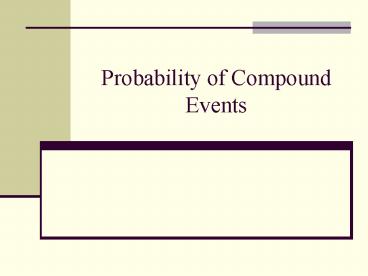Probability of Compound Events - PowerPoint PPT Presentation
1 / 23
Title:
Probability of Compound Events
Description:
Probability of Compound Events Review of Simple Probability The probability of a simple event is a ratio of the number of favorable outcomes for the event to the ... – PowerPoint PPT presentation
Number of Views:203
Avg rating:3.0/5.0
Title: Probability of Compound Events
1
Probability of Compound Events
2
Review of Simple Probability
- The probability of a simple event is a ratio of
the number of favorable outcomes for the event to
the total number of possible outcomes of the
event. - The probability of an event a can be expressed as
3
Find Outcomes of simple events
- For Simple Events count the outcomes
- Examples
- One Die- 6 outcomes
- One coin- 2 outcomes
- One deck of cards- 52 outcomes
- One fair number cube- 6 outcomes
4
Finding Outcomes of more than one event
- The total outcomes of each event are found by
using a tree diagram or by using the fundamental
counting principle. - Example
- At football games, a student concession stand
sells sandwiches on either wheat or rye bread.
The sandwiches come with salami, turkey, or ham,
and either chips, a brownie, or fruit. Use a tree
diagram to determine the number of possible
sandwich combinations.
5
Tree diagram with sample space
6
Answer
- Using the fundamental counting principle
- bread x meat x side
- 2 x 3 x 3 18 outcomes
7
More on the fundamental counting principle
- Sometimes the number of outcomes changes after
each event depending upon the situation - Example
- There are 8 students in the Algebra Club at
Central High School. The students want to stand
in a line for their yearbook picture. How many
different ways could the 8 students stand for
their picture?
8
Counting principle cont
- The number of ways to arrange the students can
be found by multiplying the number of choices for
each position. - There are eight people from which to choose for
the first position. - After choosing a person for the first position,
there are seven people left from which to choose
for the second position.
9
Counting Principle
- There are now six choices for the third position.
- This process continues until there is only one
choice left for the last position. - Let n represent the number of arrangements.
Answer There are 40,320 different ways they
could stand.
10
Probability of Compound Events
- A compound event consists of two or more simple
events. - Examples
- rolling a die and tossing a penny
- spinning a spinner and drawing a card
- tossing two dice
- tossing two coins
11
Compound Events
- When the outcome of one event does not affect the
outcome of a second event, these are called
independent events. - The probability of two independent events is
found by multiplying the probability of the first
event by the probability of the second event.
12
Compound Event Notations
13
Compound Probability
- P(roll even , spin odd)
14
Probability of Compound events
P(jack, tails)
15
Compound Events
- Events that cannot occur at the same time are
called mutually exclusive. - Suppose you want to find the probability of
rolling a 2 or a 4 on a die. P(2 or 4) - Since a die cannot show both a 2 and a 4 at the
same time, the events are mutually exclusive.
16
Compound Mutually Exclusive
17
Mutually Exclusive
- Example
- Alfred is going to the Lakeshore Animal Shelter
to pick a new pet. Today, the shelter has 8 dogs,
7 cats, and 5 rabbits available for adoption. If
Alfred randomly picks an animal to adopt, what is
the probability that the animal would be a cat or
a dog?
18
- Since a pet cannot be both a dog and a cat, the
events are mutually exclusive.
The probability of randomly picking a cat or a
dog is
19
- Example Two
The French Club has 16 seniors, 12 juniors, 15
sophomores, and 21 freshmen as members. What is
the probability that a member chosen at random is
a junior or a senior?
20
Compound ProbabilityMutually inclusive
The P(king or diamond)
(there is a king of diamonds that can only be
counted once) This is called mutually inclusive.
21
Practice
- 1. P(heads, hearts)
- 2. P(tails, 4 or 5)
- 3. P(H or T, face card)
22
Practice
- 1. P(roll even , spin odd)
- 2. P(roll a 2 or 3, spin a 7)
- 3. P(roll a 7, spin an even )
23
Assignment
- Complete the worksheet































